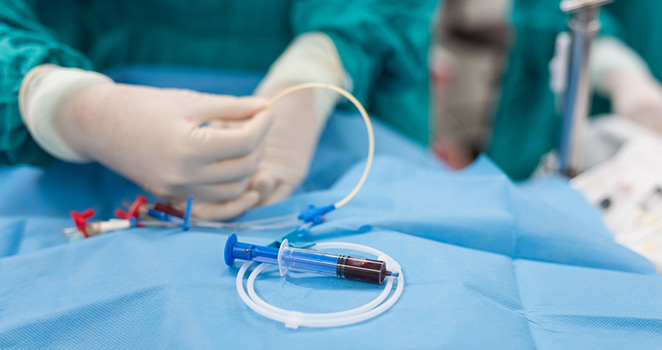Atrium Health Navicent Heart & Vascular Care
Carotid Stent

What Is Carotid Artery Disease (CAD)?
he carotid arteries are the arteries that supply the neck and head with blood, making them essential to human life and health. It is not surprising that carotid artery disease affects the wellbeing of patients across the country.
Carotid Artery Disease (CAD) is usually caused by the atherosclerosis of the carotid arteries, which means a buildup of fat and cholesterol, or plaque, has narrowed the artery, reducing the flow of blood. This reduced flow of blood means that blood cannot supply the brain with enough oxygen and can result in stroke or death.
How Can Carotid Artery Disease Be Treated?
Carotid artery disease usually is caused by lifestyle choices, so a lifestyle is the first prescription of most doctors. Maintaining a healthy weight through physical activity and heart-healthy eating greatly reduces the buildup of plaque in the arteries and fosters overall good health. Other factors might be stress or smoking, which can both exacerbate carotid artery disease.
Beyond maintaining a healthy lifestyle, medicines can be administered to thin the blood. Anti-clotting drugs like aspirin or Clopidogrel are two common blood thinners prescribed to people with plaque buildup. Statins may also be prescribed to people with peripheral diseases like diabetes.
If a healthy lifestyle and medicine are not enough to reduce the symptoms of carotid artery disease, medical procedures are available. Carotid angioplasty and stenting are the most common procedures employed in treating carotid artery disease.
What Is a Carotid Stent?
When carotid artery disease is severe, medical intervention may be necessary. The least invasive procedure to alleviate the buildup of plaque in the carotid arteries is carotid stenting. A carotid stent is an expandable tube that enlarges the carotid artery subject to the plaque.
To insert the stent, a doctor inserts a catheter through an entry point in the groin and enters the femoral artery. Using the femoral artery as an avenue toward the carotid artery, the doctor uses imaging equipment to guide the catheter into the blockage. Once in the carotid artery, the doctor releases a dye so that the artery shows up on X-ray images. This both diagnoses carotid artery disease and allows it to be treated.
Using a guide wire within the catheter, the doctor then guides a balloon and the carotid stent into the artery. The balloon is nestled inside the stent and can be inflated to expand the stent just enough to expand the artery by pushing against the artery wall. Once the doctor has expanded the artery to a satisfactory diameter, the balloon is removed, leaving only the carotid stent. The body recognizes the stent and allows cells to grow around it, leaving few side effects.
The stent expands the artery walls, allowing blood to flow normally again. It also serves to seal any tears plaque buildup might have caused in the artery. Furthermore, it prevents the clot from breaking off and possibly causing a stroke.
The entire procedure is usually performed in less than two hours.
How Do I Prepare for a Carotid Stent?
Doctors generally have patients perform at least some of the following prior to major procedures.
Patients are asked to abstain from eating, drinking, or smoking for a certain period of time prior to the procedure.
A complete physical examination is performed to assess the suitability of the procedure for the patient.
The patient is asked to list all the drugs he or she is currently taking and the dosages of those drugs are then altered as appropriate. Usually, blood thinners are stopped before the procedure.
For the best result, patients thinking about getting a carotid stent should research the hospital they are thinking about getting the procedure done at. Rates of complication should be accessible publicly. The skill of the surgeon performing the carotid stenting is extremely important in determining whether the procedure is successful.
It is also important to discuss with your primary care provider how much stenting would improve your health and quality of life over lifestyle changes and medicine. Often, an increased rate of physical activity and a healthier diet can be more effective than a medical procedure in reducing the buildup of plaque in the carotid arteries.
How Long Is the Recovery Period After Carotid Stenting?
The recovery period after carotid stenting is usually one or two weeks, including one or two days in the hospital.
Immediately after the procedure, a patient's heart rate and blood pressure are closely monitored. The catheter insertion site, usually the groin, will be compressed by a large bandage to prevent bleeding. Implements may be employed to keep the patient's legs straight.
After one or two days in the hospital, the patient is allowed to go home. There may be bruising or a lump where the catheter was inserted, and the area might be sore for several days. Although light activity is allowed, most patients do not recover completely for another one or two weeks.
Most patients will be urged to take medicine to prevent clotting to prevent a stroke. Doctors will also discuss lifestyle changes like managing weight, being active, and quitting smoking with the patient so he or she can prevent further carotid artery blockages.
What Are the Risks of Carotid Artery Stenting?
As with any major medical procedure, carotid artery stenting comes with a number of risks, including stroke, infection, bleeding, heart attack, or damage caused by the insertion of the catheter.
Overall, carotid artery stenting is safe for those under the age of 70. Older patients run a much higher risk of stroke or death during the procedure.